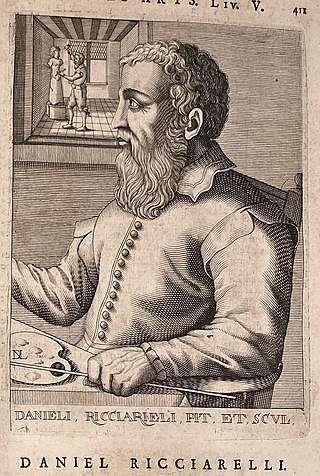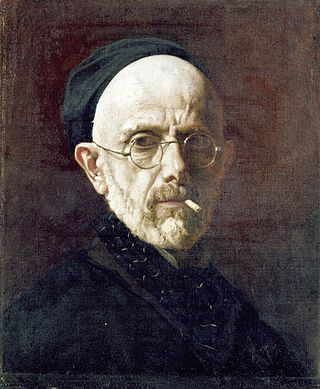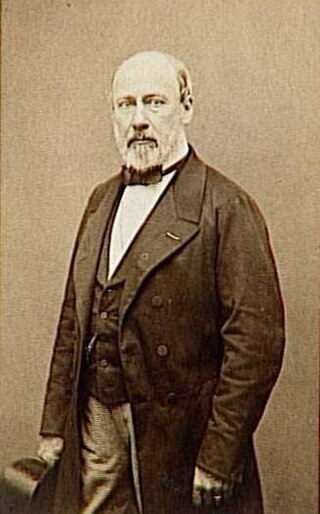This article needs additional citations for verification .(November 2015) |

as a Beggar (1894)
Michelangelo Pittatore (12 February 1825, Asti - 24 March 1903, Asti) was an Italian painter who specialized in portraits and religious paintings.
This article needs additional citations for verification .(November 2015) |

Michelangelo Pittatore (12 February 1825, Asti - 24 March 1903, Asti) was an Italian painter who specialized in portraits and religious paintings.
His father originally wanted to be a painter, but gave it up to support his family, becoming a framer and decorator instead. When he saw that his son had some artistic talent, he sent him, at the age of eleven, to study with Agostino Cottolengo, who he remained with until 1838. [1] When he turned fourteen, his father decided that he needed more formal instruction and enrolled him in classes at the Accademia di San Luca in Rome. He also copied works by the Old Masters and created some original works inspired by theirs.
In 1845, he received his first commission, from the knights of the Supreme Order of the Most Holy Annunciation, for portraits that would be presented to Queen Maria Cristina. [1] The Queen was impressed and, two years later, commissioned him to do decorations for the Sanctuary of Oropa (designed by Canina), as well as some private residences. He remained in Rome until 1848, when political events made it wiser to go back home.
Thanks to commissions from the Vicar of Costigliole, he was able to return to Rome in 1852. He soon became an habitué of the Antico Caffè Greco, where he became a lifelong friend of Rudolf Lehmann. [1] For a time, he concentrated on works that combined traditional still-lifes with elements of genre painting, although continuing to do his usual portraits. He made occasional trips home, where he created some religious works, then returned there in 1859.
In 1868, possibly at the prompting of his friend, Lehmann, he moved to London. Once there, he became part of the city's Italian community and made the acquaintance of Giuseppe Mazzini, [1] who gave him a letter of introduction that gained him entry to the upper echelons of Victorian society. The high point of his career there was an exhibition at the Royal Academy of Arts.
He returned to Italy in 1872 where, after 1880, his portraits began to show the influence of photography. He died peacefully at home in 1903. In his will, he left 10,000 Lire to the city of Asti, to be used for art education.

Michelangelo Merisi da Caravaggio, known mononymously as Caravaggio, was an Italian painter active in Rome for most of his artistic life. During the final four years of his life, he moved between Naples, Malta, and Sicily until his death. His paintings have been characterized by art critics as combining a realistic observation of the human state, both physical and emotional, with a dramatic use of lighting, which had a formative influence on Baroque painting.

Raffaello Sanzio da Urbino, now generally known in English as Raphael, was an Italian painter and architect of the High Renaissance. His work is admired for its clarity of form, ease of composition, and visual achievement of the Neoplatonic ideal of human grandeur. Together with Leonardo da Vinci and Michelangelo, he forms the traditional trinity of great masters of that period.

Jean-Auguste-Dominique Ingres was a French Neoclassical painter. Ingres was profoundly influenced by past artistic traditions and aspired to become the guardian of academic orthodoxy against the ascendant Romantic style. Although he considered himself a painter of history in the tradition of Nicolas Poussin and Jacques-Louis David, it is his portraits, both painted and drawn, that are recognized as his greatest legacy. His expressive distortions of form and space made him an important precursor of modern art, influencing Picasso, Matisse and other modernists.

Ferdinand Victor Eugène Delacroix was a French Romantic artist regarded from the outset of his career as the leader of the French Romantic school.

Annibale Carracci was an Italian painter and instructor, active in Bologna and later in Rome. Along with his brother and cousin, Annibale was one of the progenitors, if not founders of a leading strand of the Baroque style, borrowing from styles from both north and south of their native city, and aspiring for a return to classical monumentality, but adding a more vital dynamism. Painters working under Annibale at the gallery of the Palazzo Farnese would be highly influential in Roman painting for decades.

Domenico di Tommaso Curradi di Doffo Bigordi, professionally known as Domenico Ghirlandaio, was an Italian Renaissance painter born in Florence. Ghirlandaio was part of the so-called "third generation" of the Florentine Renaissance, along with Verrocchio, the Pollaiolo brothers and Sandro Botticelli. Ghirlandaio led a large and efficient workshop that included his brothers Davide Ghirlandaio and Benedetto Ghirlandaio, his brother-in-law Bastiano Mainardi from San Gimignano, and later his son Ridolfo Ghirlandaio. Many apprentices passed through Ghirlandaio's workshop, including the famous Michelangelo. His particular talent lay in his ability to posit depictions of contemporary life and portraits of contemporary people within the context of religious narratives, bringing him great popularity and many large commissions.

Henry Fuseli was a Swiss painter, draughtsman, and writer on art who spent much of his life in Britain. Many of his works depict supernatural experiences, such as The Nightmare. He painted works for John Boydell's Shakespeare Gallery and created his own "Milton Gallery". He held the posts of Professor of Painting and Keeper at the Royal Academy. His style had a considerable influence on many younger British artists, including William Blake.

Gerard van Honthorst was a Dutch Golden Age painter who became known for his depiction of artificially lit scenes, eventually receiving the nickname Gherardo delle Notti. Early in his career he visited Rome, where he had great success painting in a style influenced by Caravaggio. Following his return to the Netherlands he became a leading portrait painter. Van Honthorst's contemporaries included Utrecht painters Hendrick Ter Brugghen and Dirck van Baburen.
Michiel Coxie the Elder, Michiel Coxcie the Elder or Michiel van Coxcie, Latinised name Coxius, was a Flemish painter of altarpieces and portraits, a draughtsman and a designer of stained-glass windows, tapestries and prints. He worked for patrons in the principal cities of Flanders. He became the court painter to successively Emperor Charles V and King Philip II of Spain.

Pietro Perugino, an Italian Renaissance painter of the Umbrian school, developed some of the qualities that found classic expression in the High Renaissance. Raphael became his most famous pupil.

Jacques Courtois or Giacomo Cortese, called il Borgognone or le Bourguignon was a Franche-Comtois–Italian painter, draughtsman, and etcher. He was mainly active in Rome and Florence and became known as the leading battle painter of his age. He also created history paintings and portraits. He became a Jesuit later in life but continued to paint.

Sir George Hayter was an English painter, specialising in portraits and large works involving sometimes several hundred individual portraits. Queen Victoria appreciated his merits and appointed Hayter her Principal Painter in Ordinary and also awarded him a Knighthood in 1841.

Sebastiano del Piombo was an Italian painter of the High Renaissance and early Mannerist periods famous as the only major artist of the period to combine the colouring of the Venetian school in which he was trained with the monumental forms of the Roman school. He belongs both to the painting school of his native city, Venice, where he made significant contributions before he left for Rome in 1511, and that of Rome, where he stayed for the rest of his life, and whose style he thoroughly adopted.

Léon Joseph Florentin Bonnat was a French painter, Grand Officer of the Légion d'honneur, art collector and professor at the Ecole des Beaux Arts.

Daniele Ricciarelli, better known as Daniele da Volterra, was a Mannerist Italian painter and sculptor.

Henri Lehmann was a German-born French historical painter and portraitist.

Michelangelo Cerquozzi, known as Michelangelo delle Battaglie was an Italian Baroque painter known for his genre scenes, battle pictures, small religious and mythological works and still lifes. His genre scenes were influenced by the work of the Flemish and Dutch genre artists referred to as the Bamboccianti active in Rome who created small cabinet paintings and prints of the everyday life of the lower classes in Rome and its countryside. One of the leading battle painters active in Italy in the first half of the 17th century, Michelangelo Cerquozzi earned the nickname 'Michelangelo delle Battaglie'.

Florentine painting or the Florentine School refers to artists in, from, or influenced by the naturalistic style developed in Florence in the 14th century, largely through the efforts of Giotto di Bondone, and in the 15th century the leading school of Western painting. Some of the best known painters of the earlier Florentine School are Fra Angelico, Botticelli, Filippo Lippi, the Ghirlandaio family, Masolino, and Masaccio.

Italian Renaissance painting is the painting of the period beginning in the late 13th century and flourishing from the early 15th to late 16th centuries, occurring in the Italian Peninsula, which was at that time divided into many political states, some independent but others controlled by external powers. The painters of Renaissance Italy, although often attached to particular courts and with loyalties to particular towns, nonetheless wandered the length and breadth of Italy, often occupying a diplomatic status and disseminating artistic and philosophical ideas.

William Wyld was an English painter who participated at the Exposition Universelle of 1855. He was a friend of painters Ary Scheffer and Paul Delaroche.